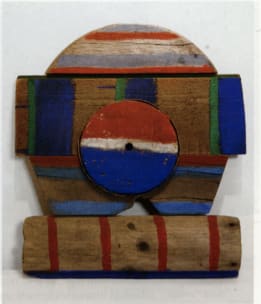The biographies of New York School artists are often sprinkled liberally with the name of Betty Parsons, who is acclaimed for staging groundbreaking shows of their work at her Fifty-seventh Street gallery. She is less well known as an artist in her own right, or rather, while the fact that she was an artist is quickly learned by those interested, the chance to see her work in depth remains rare. This show was accordingly welcome.
Parsons trained in painting and sculpture in the Paris of the 1920s, and the show included both media, though the paintings were out-numbered by reliefs—wall-mounted and freestanding constructions of found wood fragments, fitted together jigsawlike and painted with a candidly unvirtuosic hand. To the extent that Parsons’s art has a public image, these are the works that define it. They are a long way from the sculpture of her teacher, Antoine Bourdelle, who had himself been a student of Rodin’s, as his well-muscled bronzes attest. Their deliberate modesty also distances them from the best-known works of such artists in Parsons’s history as Jackson Pollock and Barnett Newman, who worked grandly on the scales of both physical size and artistic, nay, cosmic ambition. Yet Parsons’s work shows traces of Abstract Expressionism’s intellectual stew. The paintings may remind you here of Clyfford Still, there of Adolph Gottlieb, though they are, unfortunately, more static in their compositions and less distinctive in their surfaces; in the sculpture, meanwhile, the way to Parsons’s use of found materials was opened by the Surrealists and before them the Cubists, all large-shadowed ancestor figures in the AbEx genealogy. More specifically, the use of the word totem in one of Parsons’s titles here (Totem Materia-R, 1980) recalls Pollock, who used it, too (in Easter and the Totem of 1953, for example, and elsewhere), and reinforces the feeling that Parsons shared his interest in Native American art and his sense of the power of Jungian symbols and dream images.
Read full review at artforum.com.

